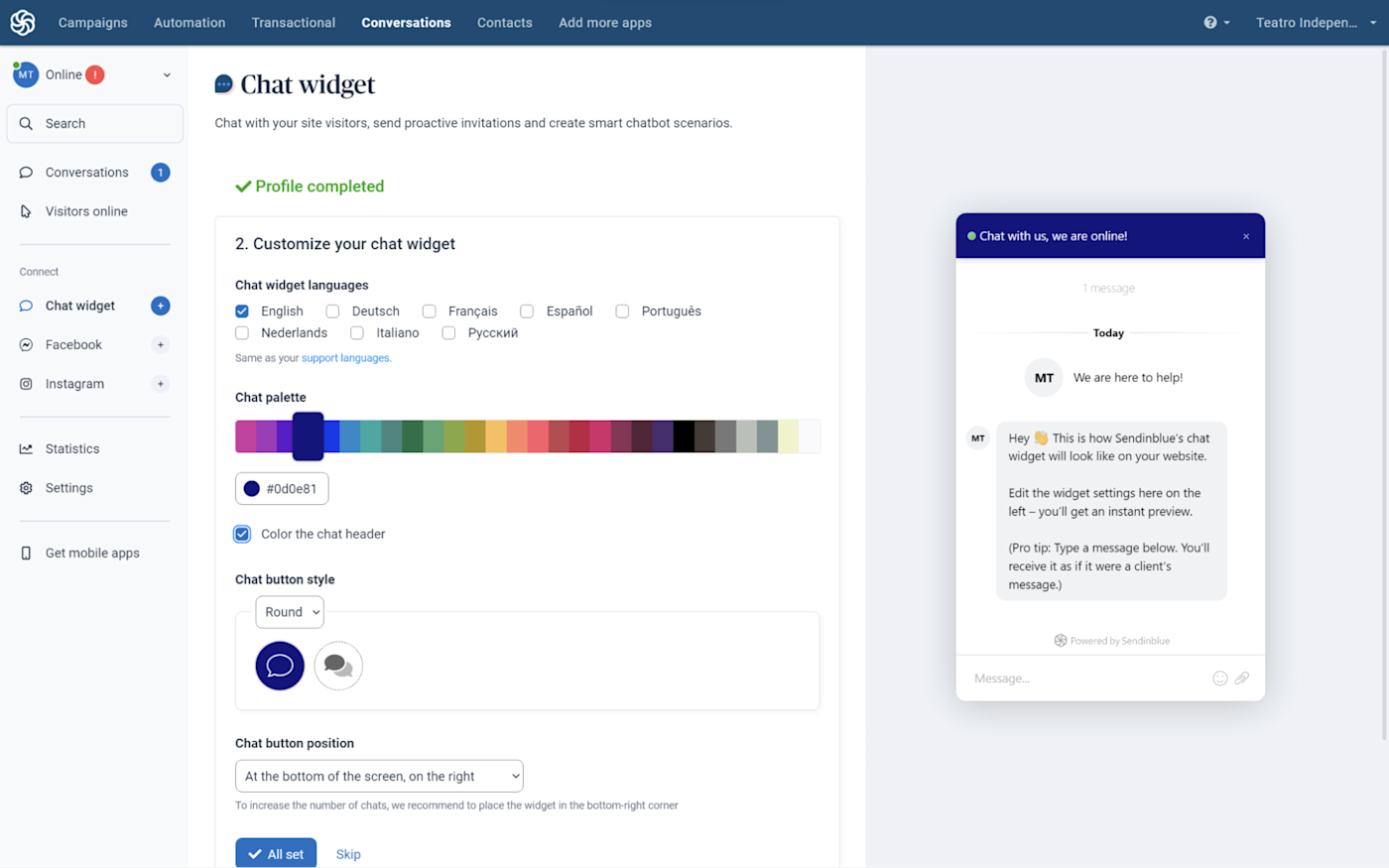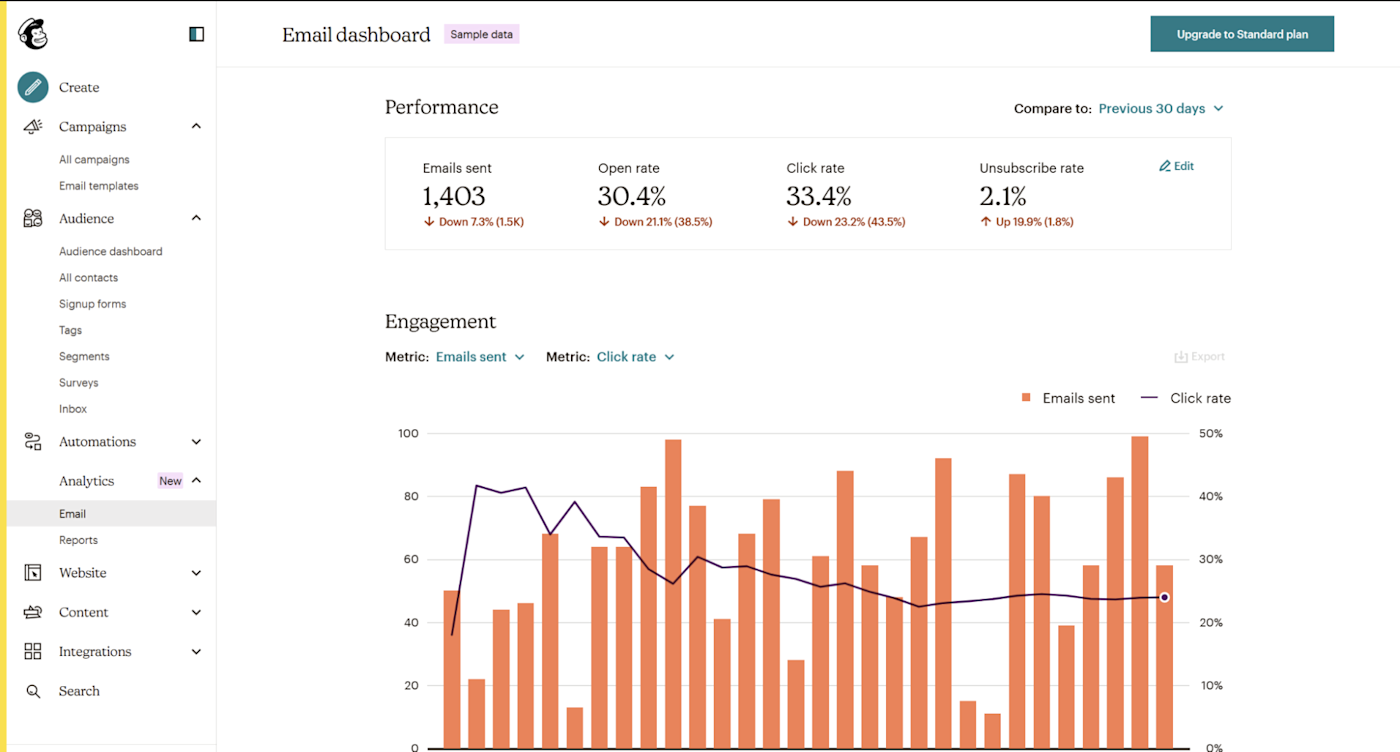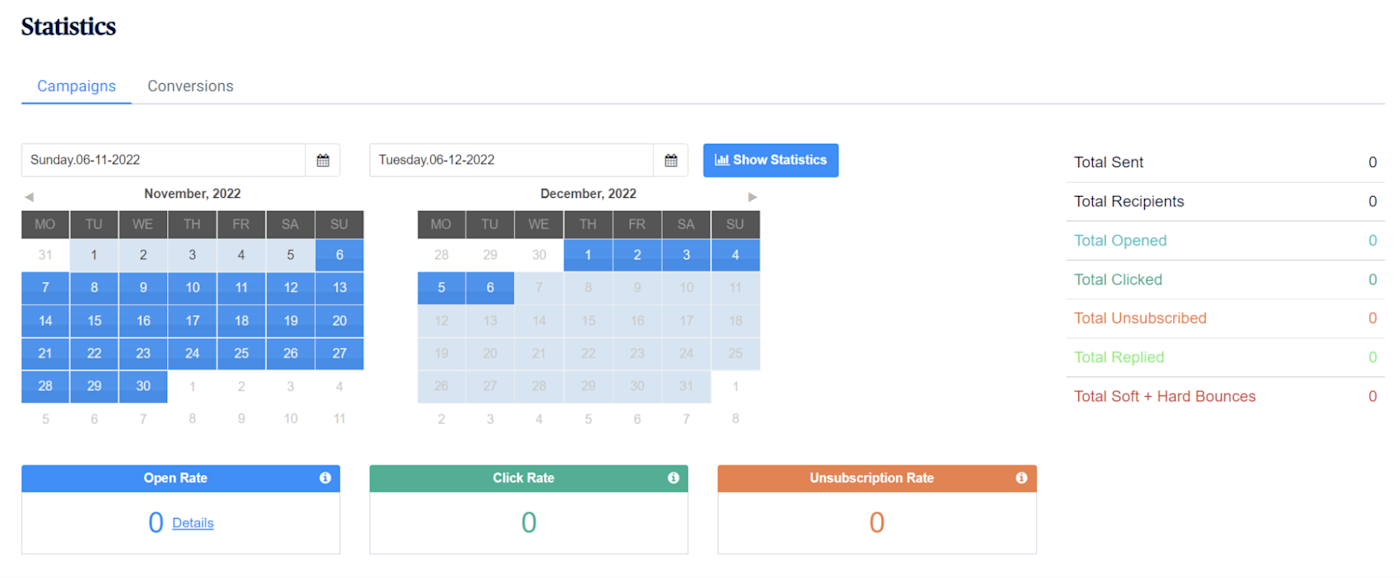Even in a world where no one is paying attention, the email inbox is still the place we trust to keep up with what matters to us. The brands that have access to it get a golden opportunity to push news, offer new products, and start conversations that aren’t possible in other channels.
I’ve been using Mailchimp for five years, and I’ve tested Sendinblue a bunch in the past for other projects. I dug deeper into both apps for this article, testing how each one works in detail to help you choose between them.
Whether you’re looking for a Mailchimp alternative or are fresh into email marketing, these details will help you decide which app is right for you.
Sendinblue vs. Mailchimp at a glance
Mailchimp is one of the most popular email marketing platforms available today. Sendinblue isn’t as well known, but it’s still competitive in terms of features and pricing. Here’s a quick overview, but keep reading for a deep dive into my experience with the apps and who they’re best for.
|
Sendinblue |
Mailchimp |
|
|---|---|---|
|
Email templates |
|
|
|
Audience segmentation |
|
|
|
Reports and analytics |
|
|
|
Extras |
|
|
|
Free plan |
|
|
|
Affordability |
|
|
Mailchimp has more marketing and social media features; Sendinblue offers SMS and chat
Mailchimp is no longer the bootstrapped email marketing platform it was back in 2001. It’s been growing for over two decades with features, and since it was acquired by Intuit, it’s working to become an all-in-one marketing beast. On top of email marketing, Mailchimp offers:
-
Customer journeys, an easy way of setting up email automation to nurture your audience
-
A website/eCommerce store builder, helping you establish a presence online
-
Social media scheduling directly from the platform, and analytics to see how you’re doing
-
Brand and content management features to help you keep all your marketing materials in one place, ready to use on your campaigns
-
Advanced analytics on all the data to help you make the right decisions

Mailchimp is more than email marketing: you can build and run your own website from the platform.
All these features are available with easy-to-use menus, accessible tutorials, and great user experience design. It’s easy to see why Mailchimp is so popular.
Sendinblue is more focused on helping you communicate with your audience. It helps you run SMS campaigns alongside email, letting you set up automations to integrate both into a rich experience across channels. In addition to opening the game to texting, it also lets you customize a live chat window that you can embed on your website. You can manage all the conversations directly within Sendinblue to handle any questions easily and quickly.

Sendinblue offers a customizable live chat widget you can embed on your website, along with the tools to keep track of the conversation.
Another hidden advantage of Sendinblue is the fact that you can truly use it as a CRM. Since it has unlimited contacts, you’ll never hit a wall, and you can even set up a sales pipeline to keep track of deals you’re negotiating. The features here aren’t super advanced—at least when compared with a real CRM app—but they’re pretty good if you’re still hanging out in front of Excel. Cherry on top? All CRM features are free to use.
Sendinblue has better subscriber segmentation for a lot less
Segmentation is the true power behind email marketing, and Sendinblue is more flexible than Mailchimp in this regard.
First, you can sort your subscribers into lists. Want to keep track of people who signed up through your website? Do it. What about another for highly engaged subscribers? Go ahead. You can either add contacts manually or set filtering rules based on contact attributes. Once you have all the lists you need, you can put them inside folders, keeping everything organized.
What’s impressive is what happens when you set up a campaign. You can choose which list (or lists) you want to target and which lists you don’t want to target, keeping those subscribers out of the campaign if it doesn’t make sense to them. You can even set filters to add in or keep out individual subscribers based on their data—say, if you’re sending out a newsletter promoting clothing for women, you could exclude all contacts with their gender set to male.

Once you segment your subscribers in Sendinblue, you can create a campaign and target the lists you want with a lot of flexibility.
And what really surprises me is that these segmentation features are available on all plans, even the free one.
Mailchimp isn’t as flexible. Your contacts are organized in audiences, and it works like the lists I mentioned above. You can create segments within this audience, and even add tags to subscribers, helping you sort people based on their activity or their custom field data.

Mailchimp lets you create segments for your audience, helping you group up your subscribers based on data and behavior.
This is awesome while you’re organizing your audience, but things get complicated when creating a campaign: on most plans, you can only target one audience and one segment or tag. If you want similar flexibility as in Sendinblue, you’ll have to upgrade to the highest pricing plan, Premium, going for $350/month for 500 contacts.
To get around this limitation, you could create multiple campaigns for different audiences and segments. This is quite a chore, though, so if you rely on segmentation and don’t have the deepest pockets in history, Sendinblue is the best option.
Mailchimp has better analytics
If you’ve been working in performance marketing for a while, you know it’s all about the data. Powerful analytics removes the guesswork, helping you sync with your audience’s needs much faster. Mailchimp is here to guide you: it goes beyond the basic email marketing stats to give you a higher-resolution view of what’s happening.

Mailchimp’s analytics are detailed without being overwhelming, helping you make changes where you need to.
The analytics tab has two subsections:
-
Email lets you take a deep look at email marketing metrics, showing you the numbers and trends for emails sent, opens, clicks, and unsubscribes. You can set a date range and isolate metrics you want to look at in-depth.
-
Reports has a list of all the campaigns you sent in the past, going really deep into the top links clicked on each email, benchmarking stats (is your open rate higher than others in your industry?), 24-hour open performance, subscribers with most opens, and geolocation.
The numbers game gets more interesting when you connect your eCommerce shop into Mailchimp. You’ll be able to access stats like campaign revenue, revenue by subscriber, and the almighty ROI. All of it in easy-to-understand charts and tables, with some recommendations in the mix to help you improve.
With Sendinblue, you won’t be flying blind, but you won’t be able to see very far. You can see who opened and clicked your emails, who unsubscribed, and a bounce breakdown. This is available for both your email and SMS campaigns.

Sendinblue’s simple statistics page provides a view of the basics.
If you head over to Settings and click on Conversions, you’ll be able to set objectives for each campaign, letting you measure whether you’re hitting webinar sign-up targets, for instance. An interesting feature, for sure, but setting it up is complex and involves a bit of time. If you want to stay on top of the data, Mailchimp is the faster, better choice.
Sendinblue offers transactional email on all plans
Transactional email is about delivering confirmations, notifications, and automated reminders. Sendinblue includes these in all their plans, even the free one.
If you’re just handling transactional email with the free plan, the 300 daily limit should be easy to control if your shop isn’t very chatty. Want to run email marketing on top of that too? Be careful: if you run out of emails in one day, you won’t be able to send those critical automated notifications to your subscribers until the next day. Keep an eye on the counter on the dashboard page and play safe.
Another key aspect of transactional email is tied to dedicated IPs. When you send your email campaigns with Sendinblue, they get sent via a set of shared IPs. This means that your emails and those of your less ethical marketer neighbor come from the same place, which could have mailboxes marking it as a promotion or, worse, outright spam. When delivering critical notifications, having a dedicated IP helps these messages break through those filters, landing in your subscribers’ inboxes. This will cost $21 per month with Sendinblue as an add-on to the regular pricing plans.
Mailchimp also offers transactional email, but you have to purchase it as an add-on on top of the subscription price. It starts at $20 for 25,000 emails, and the price per email goes down the more you need. A dedicated IP is $29.95 per month, making it a bit pricier than Sendinblue on both fronts.
Mailchimp has more native integrations, but both apps connect to Zapier
If you love knitting powerful apps together, Mailchimp has more native integrations (around 250, compared to Sendinblue’s 60ish), which will help make these connections more seamless. But both tools let you connect to thousands of other apps with Zapier. Here are some ideas to get you started, so you can automate your business-critical workflows and focus on the human work.
Zapier is a no-code automation tool that lets you connect your apps into automated workflows, so that every person and every business can move forward at growth speed. Learn more about how it works.
Sendinblue’s free plan is much better, and the paid plans are more affordable
The standard pricing strategy for email marketing tools is almost always the same: there are two to four tiers with increasingly better features, and the price then scales based on your contact list size and how many emails you send out each month. Sendinblue follows this rule with one valuable difference: it doesn’t care about the size of your list. The price goes up based only on your monthly email sending volume.
The free plan lets you send up to 300 emails per day to your contacts, a total of 9,000 emails every 30 days. You’d expect a basic set of features, but Sendinblue packs a lot into the free plan:
-
You can set up email automation with very few limitations in terms of triggers, actions, and delays for up to 2,000 contacts
-
There are SMS campaigns in the mix—you’ll have to buy some credits on a pay-as-you-go basis for each text, though
-
Advanced segmentation to group and tag every subscriber
-
Transactional email
When you outgrow the limits of the free plan, Sendinblue offers inexpensive increases to the monthly email sending volume. Hop on the Starter plan for $25 and raise the roof to 20,000 emails per month. If you need to send up to 100k emails per month, that’ll cost you $69 per month. Bear in mind that if you want the advanced features of the Business plan, the price goes up a bit to justify the extras, which are mainly multi-user support, unlimited marketing automation, and better reports.
Mailchimp is in line with the standard in terms of pricing: it charges you based on your contact list and your sending volume. It used to have a generous free plan with a 2,000 contact limit, but that limit went down to 500 contacts and 2,500 emails per month. It includes:
-
Simple automation features (abandoned cart and a welcome sequence)
-
1 audience (subscriber list)
-
1 user
-
A limited selection of email templates
-
Basic reports
Hopping on the lowest paid plan, Essentials (for $13 per month), will add more features to your account, but it won’t raise the contact limit. To get the same email sending volume as Sendinblue’s starter plan, you’d have to pay $39 in Mailchimp, and bumping it to 100k emails per month goes to $100. The pricing scales up very sharply, especially if you want to unlock the good stuff of the higher tiers.
If price is an issue, Sendinblue can send a lot of emails for you without asking as much in return. It’s an affordable option to reach a wider audience without reaching deeper into your wallet.
Mailchimp vs. Sendinblue: Which one should you choose?
Here’s the summary:
-
You should go with Sendinblue if you need an inexpensive email marketing platform, you have a large contact list, or you value strong subscriber segmentation features.
-
You should go with Mailchimp if you want to improve your email marketing with advanced analytics, you’re looking for an all-in-one marketing tool, or native integrations are critical for you.
Related reading:
[adsanity_group align=’alignnone’ num_ads=1 num_columns=1 group_ids=’15192′]
Need Any Technology Assistance? Call Pursho @ 0731-6725516








